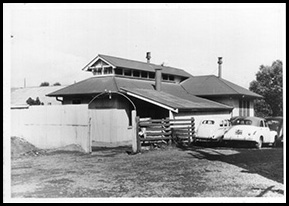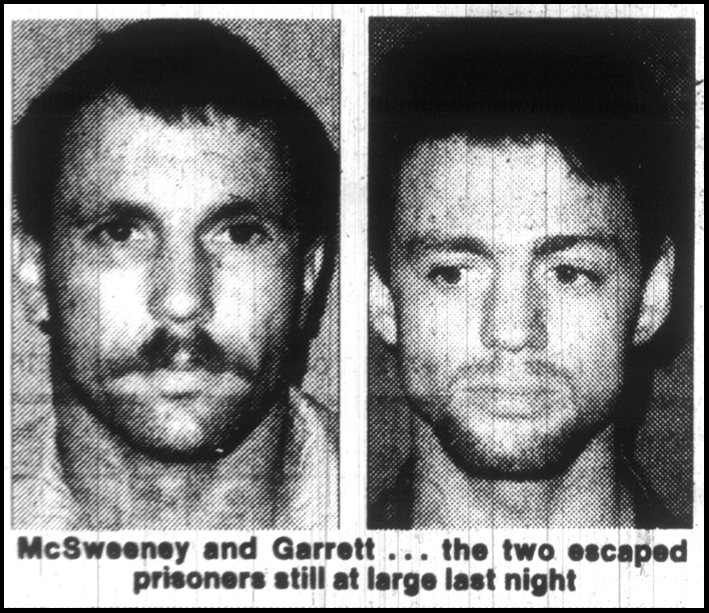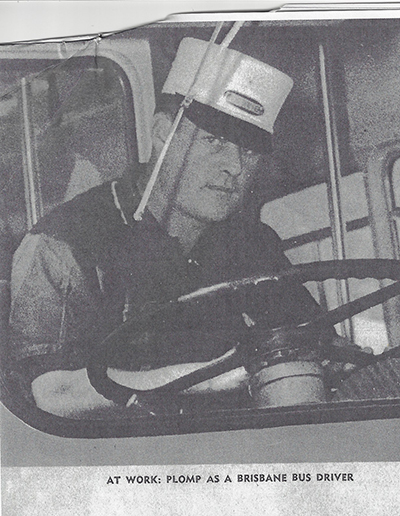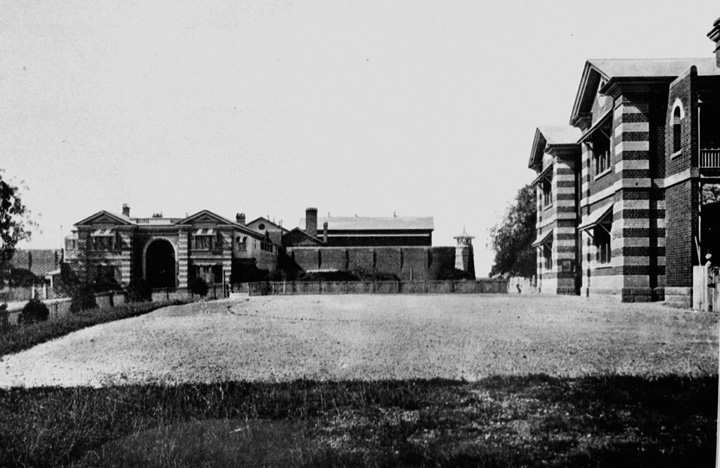THE HAUNTED HOBO PART 2: HARRY BROWN (1937)
This week we conclude our chilling story of the Haunted Hobo. We take up our tale in the Brisbane City Morgue as the government pathologist examines the body of the victim Harry Brown, who’s life was brutally ended in Victoria Park by a man he thought to be his friend.
A violent maniac on the lose, police blocked all roads into and out of Brisbane, intent on capturing the killer before he struck again. As the injuries to the victim were revealed detectives knew that they were dealing with a lunatic driven by the belief that ghosts were after him. When they finally captured their man, even hardened investigators realised just how demented the situation was.
For this and more crime & ghost stories listen to Australia’s longest running true crime show “True Crimes” – presented by Jack Sim on 4BC Nights with Walter Williams. Thursday evenings 9.35pm on Radio 4BC.
WIFE OF A ‘CRIM’ : GLORIA MCSWEENEY (1991)
While notorious characters often gain headlines, internet, TV and radio coverage the people behind them, their families and friends rarely do. Although popular media often portrays criminals as violent, mindless monsters for those that love these men (and women) they are still husbands, fathers, lovers and parents. It is rare to hear about the private life of these unlawful figures. Gloria McSweeney wife of jail-breaker and armed robber Harold McSweeney shared her life with such a man.
22 years ago, Harold John McSweeney – Harry to those who knew him – had become a household name. McSweeney was the mastermind of what became known as the “garbage truck escape”. Along with 3 others he commandeered a garbage truck doing a pick up inside Boggo Road Gaol and smashed it through the front gates of the prison. While on the run, Harry robbed banks and armoured vehicles. McSweeney was eventually recaptured, after surrendering to Channel 7 News presenter Frank Warrick at Crows Nest near Toowoomba. Gloria McSweeney, Harry’s wife was witness to it all.
To say she is a colourful character is an understatement. Gloria McSweeney has been a champion kick boxer, prison councillor, drag racing driver (she drove a Toyota Celica called “Kickboxer”), hosted 4 Triple-Zed “Prisoner Show” and also a “crim” herself. The defacto wife of Harold McSweeney, Gloria had an intimate insight into the mind and machinations of a man that few ordinary people thankfully never had to know. To her however he was special.
Together since he was a ‘pimply-faced, smart-arse’ Gloria was the most important person in Harry’s life, as he was hers. Gloria carries on her body several tattoos showing her devotion to her husband. Thursday 28th August 2014 on True Crimes we speak with Gloria about her life and her life with Harry
[soundcloud url=”https://api.soundcloud.com/tracks/169116677″ params=”auto_play=false&hide_related=false&show_comments=true&show_user=true&show_reposts=false&visual=true” width=”100%” height=”200″ iframe=”true” /]
For this and more crime & ghost stories listen to Australia’s longest running true crime show “True Crimes” – presented by Jack Sim on 4BC Nights with Walter Williams. Thursday evenings 9.35pm on Radio 4BC.
Experience Boggo Road Gaol through Tours and Events
Our policy is to allow people who claim a connection with Boggo Road to tell their story, in their own words, without editing so long as it is not libelous or defamatory. Sometimes what they say is challenging and even incorrect as memories can be fallible, however it is still their story. Readers can decide whether they believe her account or not. Relatives do not believe Gloria’s story that she was in a relationship with Harold. Harry McSweeney was married before he went to jail and was still married at the time of his death.
THE HAUNTED HOBO PART 1 : HARRY BROWN (1937)
Brisbane has a fascinating Haunted History. Jack Sim manager of Brisbane Ghost Tours loves nothing better than finding old ghost stories and trying to discover whether there is any truth in the tale. A great Brisbane oral tradition is the story of the “Haunted Hobo”. Told by homeless men and Queensland Railways workers in the 1940s, 50s and 60s the story centred on a brutal murder which happened at Victoria Park. While many people still do not believe in ghosts, Jack has found that ghost stories are rarely fabricated out of thin air. Almost invariably ghost stories circulated before the digital age were sparked out of a real incident – a death, tragedy, crime or murder. The hard part is finding that original incident. While carrying out research at the Queensland State Archives, in a musty old crime file, Jack found the answer to this old Brisbane ghost story that he first learned of from his Grandfather in the 1970s…
When hobo Harry Brown was found murdered in 1937 police had a mystery on their hands. There was some difficulty identifying him. His fingerprints were not known to them (i.e. he was not a “crim”) and detectives suspected that “Brown” was not his real name. Harry was an itinerant railway worker, living with other workers in a camp at Normanby in Brisbane. Harry had travelled the state in the company of a younger man whose mental condition had begun to deteriorate; believing that he could speak to the dead Harry’s friend became increasingly paranoid. Spirits told “Darky” to kill. The men at the camp were increasingly concerned that their demented co-worker was dangerous.
Close midnight “Darky” brained his friend with an iron bar and cut Harry’s throat. Harry’s mutilated body was found later that night. By the early 1940s railway workers believed that Harry’s ghost lingered near the place where he was murdered. Queensland Railway engine drivers during their training were warned about the ghost which was said to appear on the railway tracks below the Normanby overpass. Engine drivers were advised to slow their trains as they approached the bridge and to keep an eye open for this spirit.
Want to hear about more local ghost stories? HAUNTED BRISBANE contains 13 Haunted Sites and Ghost Stories. Buy your copy on www.jacksim.com.au
Experience a HAUNTED BRISBANE Ghost tour on a walking tour or coach tour.
TO BOOK CLICK HERE
For this and more crime & ghost stories listen to Australia’s longest running true crime show “True Crimes” – presented by Jack Sim on 4BC Nights with Walter Williams. Thursday evenings 9.35pm on Radio 4BC.
“I AM SURE I FIRED THREE” THE HOLLAND PARK TAXI MURDER (1939)
This year marks 75 years since Derwent Evans Arkinstall murdered taxi driver Howard Thomas Chambers at Holland Park on Brisbane’s Southside. In June 1939, Brisbane was shocked when it was learnt that the killer was only 18 years of age. An electrician’s apprentice Arkinstall seemed a most unlikely killer. Indeed when interviewed by police soon after his arrest in Bangalow New South Wales where he had fled after committing the crime, he seemingly did not realise the gravity of what he had done: “It was not an accident, and I did not do it deliberately, yet I do not know how I did it. I just took the revolver out of my pocket and fired it.”
It was truly a terrible crime. Tom Chambers was a veteran cabbie, 74 years of age. His body was found at Slack’s Creek. He had been shot twice in the back of the head and once in the forehead – to make sure he was dead.
When he appeared in Brisbane Police Court Arkinstall was asked whether he admitted he had fired the shots that had killed Chambers. Cold-bloodedly the youth responded “They say there were only two shots, but I am sure I fired three”. Arkinstall was found guilty of murder in the Supreme Court soon after.
He would spend 43 years living behind the walls of Boggo Road Gaol becoming Australia’s longest serving prisoner at that time. In “Boggo” he was regarded as a dangerous trouble maker. In 1946 notorious escapologist Arthur Halliday, Arkinstall and Victor Travis staged one of the most daring prison breaks in Australian history. For this he was never trusted again.
His release 31 years ago was controversial. He had only one word for reporters at the time when asked what it was like to be leaving prison – “wonderful”.
The 62 years old had been released to die as a free man. In this case justice could truly have been said to have been served – prison had claimed the best part of Arkinstall’s life.
Listen to True Crime – every Thursday at 9.30pm on Radio 4BC for this and more crime stories.
THE CHERMSIDE TOMAHAWK MURDER (1959)
In 1983, Brisbane residents were shocked to read of a campaign to release a forgotten murderer from behind the bars of Boggo Road Jail. Wife killer, Jack Foy 66, was at the time Queensland’s longest serving prisoner. His savage crime, his first and only offense shocked the people of Chermside 24 years earlier.
Out on the “back track” of Number 2 Division at Boggo Road Gaol, a lonely lifer weeded and swept. This elderly figure caused no trouble and longed to hear the sound of birds once again. When asked by a new prison officer what he was in for, Jack Foy would reply ‘I got life because his wife nagged me’.
Though now a frail crippled old man, on the 18th of June 1959 Jack Foy was a fit, hardworking labourer, well-liked by his neighbours and friends, but also an alcoholic.
The 42 year-old council worker and local handy-man was addicted to drink. He and his wife Lola 41, lived in Kingsmill Street Chermside. Jack was an epileptic and should not have been drinking; a fact Lola reminded him of daily. It seems that her nagging resulted in Jack picking up a tomahawk and striking her in the head. The Foy’s neighbour Mrs Jarvis was horrified when Jack walked over to the fence and handed over his little daughter saying ‘I’ve killed Lola, could you look after the kids and call the Police?’
Foy seemed like an unlikely killer in late 1983 after 25 years in Prison, Jack Foy was released to die as a free man.
When does “life” imprisonment mean for life?
Listen to True Crime – every Thursday at 9.30pm on Radio 4BC for this and more crime stories.
THE HUSBAND WHO DROWNED HIS WIFE (1961)
The public interest in and media coverage of the trial of Gerard Baden Clay mirrors that of half a century ago when Dutchman Hank Plomp claimed his pregnant wife vanished at night after a swim. When 30 year-old Brisbane City Council bus driver Hendrikus Plomp staggered out of the surf at Southport 53 years ago to report his wife Fay missing, something didn’t add up. The saga of Plomp would carry on for years in Queensland’s courts and newspapers, and inside the walls of Boggo Road Gaol where Plomp was to serve his time. Like the case of Baden Clay, no one saw what actually happened.
Hank Plomp and his wife Fay, lived in Petrel Street Inala, Brisbane. They had two young children, Faye was pregnant with a third, at the time of the tragedy.
On February 24, 1961 Plomp took his wife to the Gold Coast on a day trip. At 6.30pm they drove to Southport. Fay, a good swimmer wanted to have one last dip at Main Beach, they entered the water leaving their son in their car.
What happened next depended on who’s version you believe. Police maintained that Plomp told them that waves knocked he and his wife over twice and that Fay was dragged under. Plomp grabbed the shoulder strap of her swim suit, but it broke and she disappeared underwater. Plomp then raised the alarm at a nearby shop ; Police were called. This version of events relayed by Plomp was later denied by him. Detectives claimed that when her body was found later that night her shoulder straps were intact.
Fay’s family and friends suspicions of murder were confirmed 45 minutes before her funeral when Hank claimed his wife’s insurance. Plomp it seemed had been living a sordid lie. After his wife’s death, he was put on trial for rape of another woman and it was revealed he had a mistress, who he had promised to marry. It seemed he had taken the advice of a work colleague ‘If you want to get rid of your wife, the easiest way is to take her swimming and hold her under. Then feel sorry and start to cry.’
The council bus driver had thought his plan to be cunningly simple. Ultimately a jury convicted him of murder after just 90 minutes. After many years Plomp was released from Boggo Road Gaol after a series of appeals against his conviction… He returned to Holland taking his family with him.
The question remains: was the shoulder strap broken or intact?
Listen to True Crimes – every Thursday at 9.30pm on Radio 4BC for this and more crime stories. Next THE CHERMSIDE TOMAHAWK MURDER (1959)
40th ANNIVERSARY OF THE FIREBOMBING OF THE WHISKEY AU GO GO
Friday 8 March marks the fortieth anniversary of the firebombing of the Whiskey Au Go Go nightclub in Fortitude Valley. One of the worst crimes ever committed in Australia, the two men found guilty of the crime, James Richard Finch and John Andrew Stuart, became household names in Queensland. From within the walls of Boggo Road Gaol they run one of the most powerful and controversial campaigns ever seen inside a gaol anywhere. They divided the community – into those who believed in their innocence – and those who knew they were guilty.
The strength of Stuarts conviction, reinforced by his dramatic actions – such as sewing his lips together with wire, swallowing wire crosses, and climbing onto the roof of A Wing cellblock and spelling out messages in bricks – “innocent’ – buzzed by media helicopters – led many to believe his story of being “verballed” by police.
This was a shadowy era as later shown by the Fitzgerald Inquiry into corruption, leading many at the time to wonder whether the career criminals may have been scapegoats. The truth behind the torching of the popular nite spot was never revealed. Stuart’s story that a group of ‘Sydney criminals’ had approached him to join them in extorting money from local nightclubs, never quite gelled. His denial of involvement was strenuous; Stuart shared his inside information with police and reporters in what he claimed was an attempt to save lives. Others regarded it as a twisted attempt to create an alibi for himself.
Whether he did the crime or not, Stuart took the truth to his grave. He was found dead in his cell at Boggo Road Gaol on New Years Day 1979.
James Finch eclipsed his friend in the media stakes ultimately. He became known as the “Birdman of Boggo Road” for his avian hobby, found love and married in prison, and found support for his claim of innocence through “the Friends of Finch” an eclectic mix of learned and ordinary citizens thoroughly convinced the man was wrongly imprisoned. Soon after his release in 1988, via a live cross to England, his native country, to which he had been deported, Finch confessed to the murders. He admitted the involvement of himself and his friend Stuart. When it was pointed out that he had only been convicted on one indictment, and that he could still be charged for the other murders, Finch retracted his admissions.
In 1973 while being locked in Number 2 Division at Boggo Road Gaol, James Finch allegedly confessed to committing the crime to a well-known prisoner while the two were working in the sanitation yard. The prisoner was called to give evidence at the trial and did so; Finch denied ever saying such a thing.
Jack Sim will be on-air on Crime Corner on radio 4BC at 1pm on Friday with Moyd and Loretta to talk about this diabolical crime.
Visit Boggo Road Gaol – see the Sanitation yard. Book a tour at www.boggoroadgaol.com
KILLER ON WAY TO BOGGO ROAD GAOL (60 YEARS AGO)
Today marks 60 years since Arthur Ernest Halliday was found guilty of the murder of taxi driver Athol McCowan. Otherwise known as “Slim”, Halliday was already well-known. In 1940, and again in 1946, he managed the seemingly impossible – escaping from Brisbane’s Boggo Road Gaol. He served a lengthy period of imprisonment following those two dramatic break-outs. Following his release in 1949, Halliday seemingly stayed out of trouble, until the discovery of a brain and blood spattered taxi cab at Southport in May 1952. Police initially had few leads, but after learning of the gaol-breakers presence on the Coast, their efforts turned to locate him. Halliday had already fled, casting suspicion on him even more strongly. READ MORE FROM THE ORIGINAL ARCHIVES…
Arrested in a dramatic shootout in New South Wales, Halliday was extradited to Queensland where he faced trial. On Monday 2 March 1953, jurors found the evidence overwhelming. Even, Justice Stanley, not known for expressing his thoughts on cases, commented ‘I agree with this verdict’. Read the front page coverage by The Courier Mail newspaper sixty years ago…
However, veteran reporter Ken Blanch in his book THE TAXI DRIVER KILLER cast doubt on Halliday’s involvement. Blanch questioned the scientific evidence presented by police of the era, and their motives. Copies of this true crime book are available HERE
To visit Boggo Road Gaol – book a tour at www.boggoroadgaol.com
HERITAGE WORK: Padlocks – Acquisitions
It never ceases to amaze us the incredible connections to Boggo Road Gaol that are out there in the community. We recently acquired four original prison padlocks from a member of the public whose father performed maintenance for the State Government at Wacol prison. Three are “Chubb” brand padlocks, commonly used to secure cell doors due to their incredible strength – the clasp was capable of withstanding 38 tonnes of pressure! One Chubb is in exceptional condition with three unused matching keys; the other two are very old and had seen a lot of use. Given their age and providence these would have come from Boggo Road Gaol. Incredibly each still has a matching key albeit worn. Chubb padlocks were used throughout Boggo Road Gaol and other Queensland prisons through the 1950s to 1980s. Expensive pieces of security in their day, they were originally manufactured in London. They are still made today retailing for approx. AU$175. The fourth padlock was a brass “Jackson” brand. These simple but strong locks were usually used on cellblock gates.
Modern collectors have driven the prices of old locks up in recent years but our interest in these was their connection to Queensland’s prison history. These rare items will be used to demonstrate to visitors on our HISTORY OF BOGGO ROAD GAOL Tour how prisoners were locked up. Any willing volunteers?
Images of the past: the two gaols at Boggo Road
THE TWO GAOLS AT BOGGO ROAD: Just after the turn of the new century, the original Brisbane Gaol (at left) was joined by a new gaol. The original Gaol was renamed H.M. Gaol for Men and H.M. Gaol for Women (right) opened to compliment it. “A” Tower can be seen on the wall of the Men’s Gaol.
Source: Queensland Parliamentary Papers, 1911-12, Volume 2.







&v=2)















